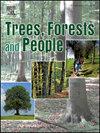Capturing trends in forest structural complexity development using laser scanning techniques
IF 2.9
Q1 FORESTRY
引用次数: 0
Abstract
Forest structural complexity reflects realized niche occupancy, capturing how effectively the vegetation utilizes available resources and provides habitats for species. This makes it a key indicator of forest ecosystem diversity, and an important characteristic to be monitored to facilitate sustainable forest management and conservation planning. Laser scanning has been recognized as a feasible technology for the characterization of heterogeneity in forest structure, reflecting its structural complexity. However, less is known about the capability of different laser scanning techniques to capture structural complexity development through time, and whether the cross-use of various data types and analysis methods yields consistent observations of the development. We aim to address this knowledge gap by investigating the capability of different laser scanning techniques to assess forest structural complexity development and evaluate whether comparable observations can be obtained regardless of the laser scanning technology used. The experiments were conducted across 49 sample plots within southern boreal forests in Evo, Finland. A 7–10-year monitoring period was captured using terrestrial laser scanning (TLS), and airborne laser scanning (ALS) at three different resolutions representing low (0.4-1 pts/m²), medium (15-28 pts/m²), and high (200-3600 pts/m²) point densities. Eight metrics were used for structural complexity characterization: mean canopy height, canopy rugosity, gap fraction, vegetation occupancy, vertical evenness (Shannon entropy), variability in crown area and tree height, and mean fractal dimensions (box-dimension) among trees. Comparison of observations of structural complexity development showed that gap fraction and Shannon entropy exhibited consistent development directions and similar metric change magnitudes across all the investigated laser scanning techniques. In contrast, metrics characterizing three-dimensional complexity, such as vegetation occupancy and mean box-dimension, were more sensitive to point cloud data characteristics. These findings provide insights into selecting appropriate laser scanning techniques and analysis methods to monitor forest structural complexity development for applications such as conservation planning.
利用激光扫描技术捕捉森林结构复杂性发展趋势
森林结构的复杂性反映了已实现的生态位占用,反映了植被如何有效地利用可用资源并为物种提供栖息地。这使其成为森林生态系统多样性的一个关键指标,也是监测促进可持续森林管理和养护规划的一个重要特征。激光扫描已被认为是表征森林结构异质性的一种可行技术,反映了森林结构的复杂性。然而,人们对不同激光扫描技术捕获结构复杂性随时间发展的能力知之甚少,以及各种数据类型和分析方法的交叉使用是否产生一致的发展观察结果。我们的目标是通过研究不同激光扫描技术评估森林结构复杂性发展的能力,并评估无论使用何种激光扫描技术,是否都可以获得可比的观测结果,从而解决这一知识差距。实验在芬兰埃沃南部北方森林的49个样地进行。使用地面激光扫描(TLS)和机载激光扫描(ALS)以三种不同的分辨率捕获了7 - 10年的监测期,分别代表低(0.4-1 pts/m²)、中(15-28 pts/m²)和高(200-3600 pts/m²)点密度。结构复杂性表征采用8个指标:平均冠层高度、冠层粗糙度、林隙分数、植被占用率、垂直均匀度(Shannon熵)、冠层面积和树高变异度以及树间平均分形维数(箱维数)。结构复杂性发展的观测结果表明,在所有激光扫描技术中,间隙分数和香农熵的发展方向一致,度量变化幅度相似。相比之下,表征三维复杂性的指标,如植被占用率和平均箱维,对点云数据特征更为敏感。这些发现为选择合适的激光扫描技术和分析方法来监测森林结构复杂性的发展提供了见解,并为保护规划等应用提供了参考。
本文章由计算机程序翻译,如有差异,请以英文原文为准。
求助全文
约1分钟内获得全文
求助全文
来源期刊

Trees, Forests and People
Economics, Econometrics and Finance-Economics, Econometrics and Finance (miscellaneous)
CiteScore
4.30
自引率
7.40%
发文量
172
审稿时长
56 days
 求助内容:
求助内容: 应助结果提醒方式:
应助结果提醒方式:


